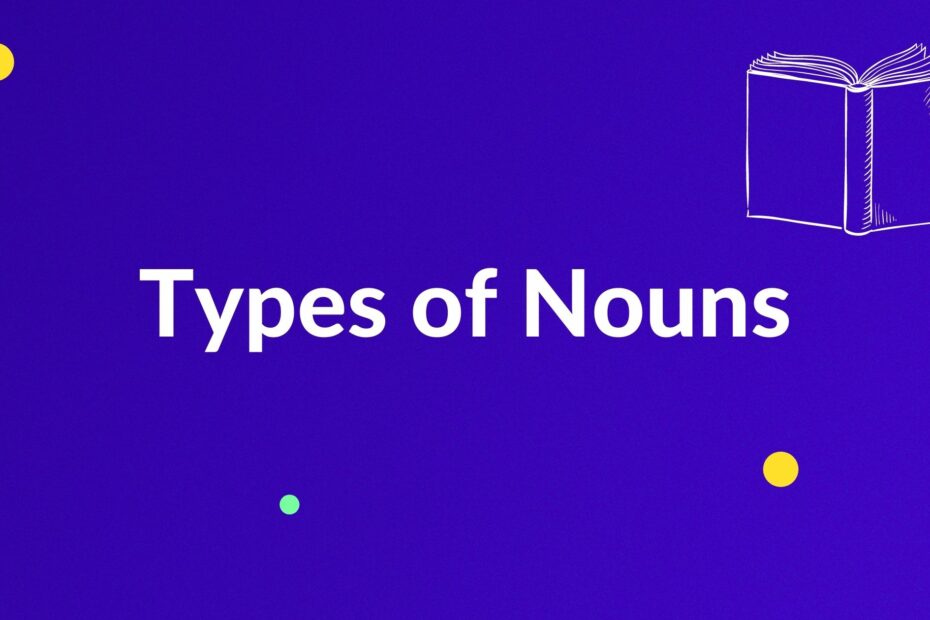There are 12 types of nouns in the English language: proper nouns, common nouns, possessive nouns, compound nouns, collective nouns, concrete nouns, abstract nouns, material nouns, countable nouns, uncountables nouns, singular nouns, and plural nouns. We use them in our speech, and writing every day. It plays an essential role in sentence structure. We know that noun is a word that names a person, place, or thing.
Understanding the Types of Nouns
Nouns are one of the most important parts of speech in the English language. There are many different types of nouns, each with its own function and purpose. Here are 12 of the most common types of nouns:
1. Proper nouns
Proper nouns are specific type of noun that represents a particular person, place, or thing. They are always written with a capital letter. Some examples of proper nouns include:
- Princess Peach
- The Bible
- The Mushroom Kingdom
- America
- Sunday
As you can see, proper nouns can represent specific people, places, or things. They are an important part of speech and can help to add detail and specificity to your writing. Be sure to use them correctly and always capitalize them to avoid any confusion.
2. Common nouns
Common nouns are the most basic type of noun and refer to general things, places, or people. It denotes any or all members of a class that is common among others. It does not refer to specific people or things.
Here are some examples of common nouns:
- Boy
- Country
- Apple
- Month
- Car
Common nouns vs. proper nouns
We can understand it better by observing that boy and girl are common nouns, but John and Sophia are proper nouns. Similarly, man and woman are common nouns, but John and Cora are the proper nouns.
However, the proper nouns are capitalized, but common nouns are not. So, we can differentiate between the proper and common nouns.
3. Possessive nouns
Possessive nouns are a type of nouns that shows ownership. They are usually formed by adding an apostrophe + s to the end of the word, as in “Bob’s bike.” In addition to showing ownership, possessive nouns can also show a relationship between two people or things, as in “the moon’s orbit around Earth.” Possessive nouns can be singular or plural, and they can be used to describe people, animals, places, or things.
Examples:
- General’s business
- Moon’s brightness
- Fish’s eggs
- House’s roof
- Sun’s light
4. Compound nouns
A compound noun is a noun that is made up of two or more words. They can be written as one word, or they can be written as two separate words. Compound nouns are usually made up of a noun and a verb, or a noun and an adjective.
Some examples of compound nouns are:
1. toothpaste
2. sunlight
3. haircut
4. bedroom
5. software
toothbrush, sunlight, workbook, classroom, coffee
5. Collective nouns
Collective nouns are used to describe a group of people, animals, or things. For example, a flock of birds, a herd of cows, or a school of fish. We often use collective nouns in speech and writing without realizing it. Here are 12 of the most common collective nouns:
1. Army
2. Audience
3. Band
4. Class
5. Committee
6. Family
7. Government
8. Group
9. Jury
10. Majority
11. Orchestra
12. Public
Concrete nouns Vs. abstract nouns
The difference between concrete nouns and abstract nouns is sometimes exclusive. Concrete nouns are that have a physical existence, but abstract nouns have no physical existence.
6. Concrete nouns
The nouns refer to something that the human senses can observe; seen, felt, touched. We can visualize concrete nouns because they have a physical existence.
For example,
- coffee bag
- Tea carpet
- rain door
- mountain flower
- beach grape
7. Abstract nouns
An abstract noun is a word for something that can’t be experienced with the five senses. They express ideas, concepts, and emotions. Abstract nouns are often created from adjectives and verbs, and they don’t usually change form whether they’re singular or plural. For example, the word “fear” is an abstract noun. You can’t see, touch, taste, smell, or hear fear, but you can feel it. Other examples of abstract nouns are love, justice, courage, and mercy.
Here are some more examples of abstract nouns:
- desire happiness
- Beauty uncertainty
- feelings time
- anger beauty
- loyalty wisdom
8. Material nouns
The material Nouns refer to something material or substance out of which other things are made. They are uncountable and do not exist in plural form.
For example,
- silver Water
- gold Cotton
- iron Cotton
- diamond Cement
9. Countable nouns
Countable nouns are those that can be counted, like people, animals, things, etc. They usually have a singular and plural form, and they can be used with numbers. For example, you could say “I have three dogs” or “I have ten cats.”
Some countable nouns have a special plural form, like child/children or man/men. Others have the same form in both singular and plural, like deer or sheep.
Examples in the following sentences,
- I’ve just bought a new flat.
- I prefer cities to the village.
- The child plays with toys.
- The school is over there.
- There are two mice in the storeroom.
Some concrete nouns are countable such as bag, chair, pen, shoes, window, etc.
10. Uncountable nouns
Uncountable nouns are things that cannot be counted or divided into separate pieces. For example, water is a non-countable noun. You cannot count the number of water, you can only count the number of bottles of water. Other examples of uncountable nouns include furniture, air, and information.
When writing about uncountable nouns, you should always use a singular verb. For example, “The furniture in the store is very expensive.” or “There is too much air pollution in this city.” You cannot say “The furniture in the store are very expensive”
Examples of non-countable nouns in the following sentences:
- Light reflects off the stream.
- Roy lived in poverty.
- Our baggage went missing.
- We are waiting for valid information.
- You should put sugar in the tea.
- I put petrol in the car today.
- I’ll have a kilo of sugar, please.
11. Singular nouns
The singular nouns refer to something a single person, place, thing, or object. Mostly articles: a/an or the, is placed before singular nouns.
For example,
- A boy
- an elephant
- one car
- two cake
12. Plural nouns
A plural noun is used to represent more than one person, place, thing, and object. Most plural nouns are formed by adding s or es to the singular noun, as in pen/pens and dog/dogs.
Singular vs plural nouns
Nouns are an integral part of speech, and there are many different types that you should be aware of. The two main categories are singular and plural nouns. Singular nouns refer to one person, place, or thing, while plural nouns refer to more than one. There are many other types of nouns in between these two extremes, and each has its own purpose and function.
Conclusion
Nouns are a part of speech that represent people, places, things, or ideas. They are necessary for communication, as they help us to identify the people, places, things, or ideas that we are talking about. learning about the different types of nouns and their functions can help you to use them more effectively in your writing.

